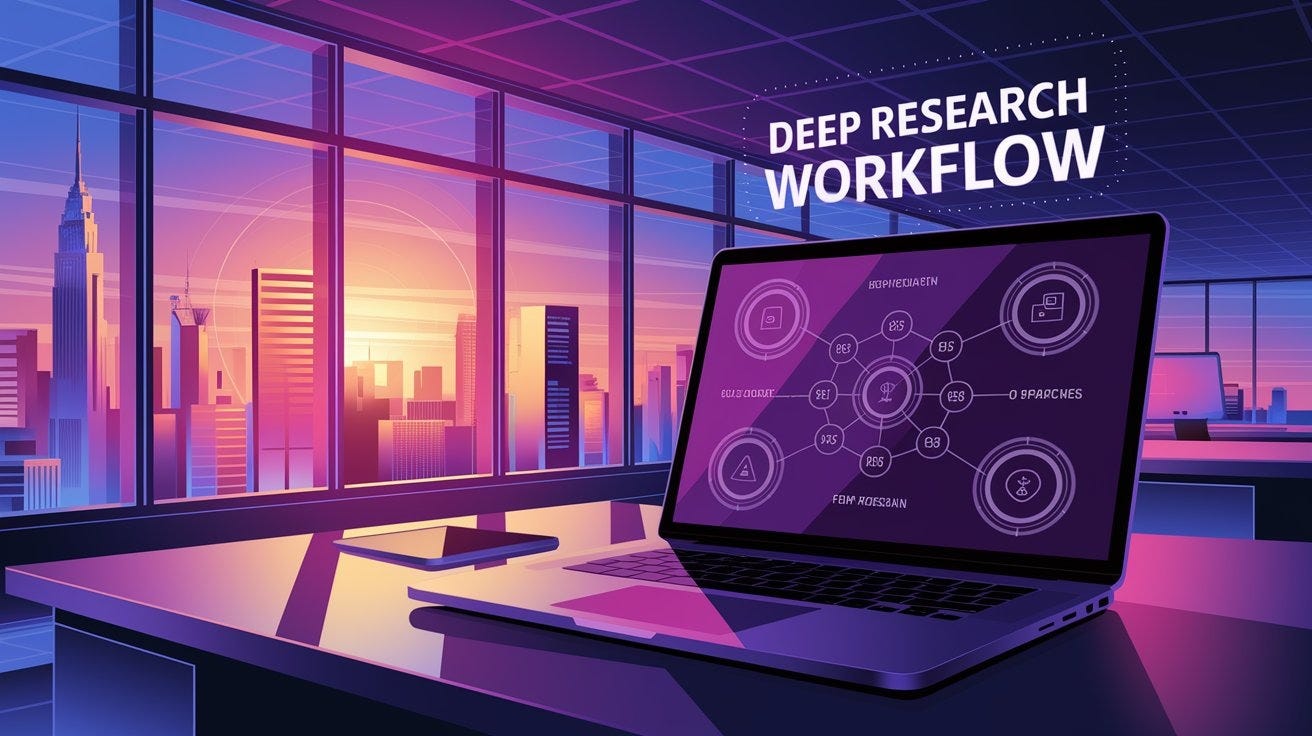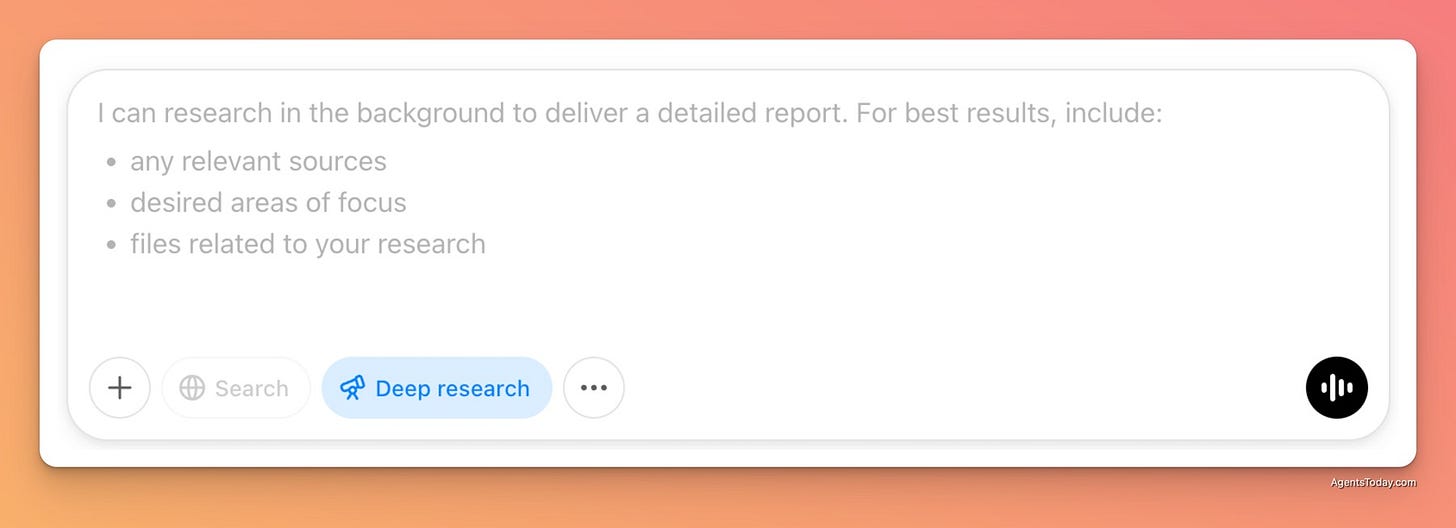Agents Today #9 - Rise of Deep Research: How AI Agents Are Transforming Online Research (Part 1)
In the rapidly evolving landscape of artificial intelligence, a new category of AI agent tools have emerged that fundamentally change how we conduct research, collectively known as "Deep Research"
In the rapidly evolving landscape of artificial intelligence, a new category of AI agent tools have emerged that fundamentally change how we conduct research. These tools, collectively known as "Deep Research" agents, represent leap forward in AI capabilities - moving from simple question-answering to autonomous, multi-step research that can save users hours or days of time. This article, the first in a series exploring Deep Research offerings, examines how these AI agents work and the specific implementations by OpenAI, Google, Perplexity, and Grok.
What is Deep Research?
Deep Research represents a new paradigm in AI - one where the AI doesn't just respond to queries based on its training data but actively searches for, analyzes, and synthesizes information from across the internet. Unlike traditional search engines that return a list of links or basic AI assistants that provide simple answers, Deep Research agents conduct comprehensive, multi-step research processes that mimic how a human researcher or analyst would approach a complex topic.
These agents can browse hundreds of websites, read and analyze documents, reason about the information they find, and compile comprehensive reports - all in a fraction of the time it would take a human researcher. The result should be a detailed, well-cited analysis that provides genuine insights rather than just surface-level information.
How Deep Research Works
While each company's implementation differ in specific details, Deep Research agents generally follow a similar workflow:
1. Planning
When presented with a research query, the AI agent first develops a structured research plan, breaking down the complex question into manageable sub-tasks. This planning phase is crucial for ensuring comprehensive coverage of the topic.
2. Searching and Browsing
The agent then executes its research plan by searching the internet, browsing relevant websites, and collecting information. Unlike simple search, these agents can navigate through multiple pages, follow links, and gather information from diverse sources.
3. Reasoning and Analysis
As information is collected, the agent reasons about it's findings, identifies gaps or contradictions, and determines what additional information is needed. This iterative process allows it to refine its understanding and adjust its research approach as needed.
4. Synthesis and Reporting
Finally, the agent synthesizes all the gathered information into a comprehensive report, complete with citations to original sources. This allows users to verify information and explore topics in greater depth if desired.
Deep Research Implementations
Let's examine how four major AI companies have implemented Deep Research capabilities:
OpenAI's Deep Research
OpenAI launched Deep Research in ChatGPT as "a new agentic capability that conducts multi-step research on the internet for complex tasks. It accomplishes in tens of minutes what would take a human many hours."
Key Features:
Powered by a version of the OpenAI o3 model optimized for web browsing and data analysis
Can search, interpret, and analyze text, images, and PDFs from the internet
Creates comprehensive reports with clear citations
Can browse user-uploaded files and create data visualizations using Python
Target Users: OpenAI designed Deep Research for "people who do intensive knowledge work in areas like finance, science, policy, and engineering and need thorough, precise, and reliable research." It's also useful for consumers researching significant purchases like cars, appliances, and furniture.
Availability:
Free Users: Not yet available to free tier users, though plans exist to offer approximately 2 uses per month in the future
Plus/Team/Enterprise/Edu Users: 10 deep research queries per month
Pro Users ($200/month): 120 deep research queries per month
Platform Support: Available on all platforms—web, iOS, Android, macOS, and Windows
Reset Period: Limits reset every 30 days from first use
ChatGPT's Deep Research typically takes between 5 to 30 minutes to generate reports, as it analyzes content from multiple sources. This feature was initially exclusive to Pro subscribers ($200/month) before being extended to other paid tiers on February 25, 2025.
Technical Approach: Deep Research was "trained using end-to-end reinforcement learning on hard browsing and reasoning tasks across a range of domains." Through this training, it learned to plan and execute multi-step research trajectories, backtracking and reacting to real-time information when necessary.
Google's Gemini Deep Research
Google describes Gemini Deep Research as a "personal research assistant" that can "automatically browse up to hundreds of websites on your behalf, think through its findings, and create insightful multi-page reports in minutes."
Key Features:
Powered by Gemini 2.0 Flash Thinking (experimental)
Transforms prompts into personalized multi-point research plans
Shows its thoughts as it reasons over information
Provides comprehensive custom research reports
Directly exportable to Google Docs
Use Cases: Google highlights several use cases for Deep Research:
Competitive analysis
Due diligence
Topic understanding
Product comparison
Availability:
Free Users: As of March 13, 2025, Deep Research is available to all Gemini users in over 45 languages
Usage Limits: Free users can access Deep Research "a few times per month" (exact number unspecified)
Premium Users: Gemini Advanced subscribers receive "expanded access" with higher usage limits
Platform Support: Currently available on the web, with mobile availability coming soon
Google's Deep Research has been upgraded to use the Gemini 2.0 Flash Thinking Experimental model, which enhances capabilities across research stages—from planning and searching to reasoning and reporting. The feature typically completes research in approximately 5-10 minutes.
Technical Approach: Google developed "a new planning system that enables Gemini app to work through complex problems." The system can break down problems into sub-tasks, determine which tasks can be done simultaneously versus sequentially, and synthesize findings into comprehensive reports.
Google notes three significant technical challenges they overcame:
Multi-step planning
Long-running inference
Context management using Gemini's 1 million token context window
Perplexity's Deep Research
Perplexity launched Deep Research "to save you hours of time by conducting in-depth research and analysis on your behalf." Their implementation focuses on accessibility and ease of use.
Key Features:
Performs dozens of searches and reads hundreds of sources
Iteratively searches, reads documents, and reasons about next steps
Synthesizes research into comprehensive reports
Allows export to PDF or document, or conversion to a Perplexity Page for sharing
Use Cases: Perplexity showcases Deep Research capabilities across various domains:
Finance
Marketing
Technology
Current Affairs
Health
Biography
Travel
Performance: Perplexity highlights their Deep Research performance on key benchmarks:
21.1% accuracy on Humanity's Last Exam
93.9% accuracy on SimpleQA
Completes most research tasks in under 3 minutes
Availability:
Free Users: 5 queries per day
Pro Users: 500 queries per day
Platform Support: Currently web-only, with plans to extend to iOS, Android, and Mac platforms
Perplexity's Deep Research completes most tasks in under three minutes, significantly faster than OpenAI's 5-30 minute timeframe. The feature has demonstrated strong performance on benchmarks, scoring 21.1% on "Humanity's Last Exam," outperforming several competing models.
Grok's DeepSearch
Grok introduced DeepSearch as part of their Grok 3 announcement, describing it as "a lightning-fast AI agent built to relentlessly seek the truth across the entire corpus of human knowledge."
Key Features:
Designed to synthesize key information and reason about conflicting facts and opinions
Produces concise and comprehensive reports
Can access the latest real-time news and conduct in-depth scientific research
Technical Capabilities: DeepSearch is built on Grok 3, which features:
A context window of 1 million tokens
State-of-the-art accuracy on the LOFT (128k) benchmark
Improved factual accuracy and enhanced stylistic control
Code interpreters and internet access
Availability:
Free Users: Available to all Grok users but with unspecified usage limits
Premium Users: X Premium+ subscribers receive access with "higher limits" (specific numbers not disclosed)
Platform Support: Not clearly specified in available information
It was released alongside Grok 3 and the "Think" feature on February 19, 2025.
The Future of Deep Research
Deep Research agents represent a significant step toward more agentic AI systems that can work independently to accomplish complex tasks. All four companies are actively developing their Deep Research capabilities, with plans to expand access and enhance functionality.
Future developments may include:
Connection to specialized data sources beyond the open web
Integration with other AI agent capabilities
Improved reasoning and analysis capabilities
Faster processing times
Enhanced visualization and reporting features
Conclusion
Deep Research agents mark a significant evolution in how AI can assist with complex information tasks. By autonomously conducting multi-step research processes, these tools can save users hours or days of time while providing comprehensive, well-cited reports.
In our next article, we'll compare these Deep Research implementations head-to-head, examining their strengths, weaknesses, and unique capabilities to help you determine which might best suit your specific research needs.











Thanks for the overview and summary! As you have been testing them, what are you finding about each model over the last couple of months?